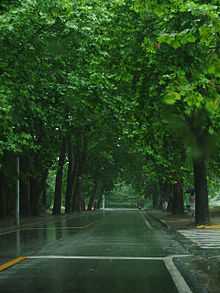Chungbuk National University
| Chungbuk National University | |
|---|---|
| 충북대학교 | |
 | |
| Motto |
Korean: 진리·정의·개척 Latin: NOVA APERIO (University that Opens New things) |
| Established | 1951 |
| Type | National |
| President | Dr. Kim Seung-Taek |
| Academic staff | 709 (2005) |
| Students | 18,991 (2005) |
| Undergraduates | 14,539 (2005) |
| Postgraduates | 4,352 (2005) |
| Location | Cheongju, South Korea |
| Campus | Urban |
| Colors | Crimson |
| Nickname | 충대 (ChungDae) |
| Mascot | Bull |
| Website | www.cbnu.ac.kr (Korean), http://www.cbnu.ac.kr/eng/ (English) |
| Chungbuk National University | |
| Hangul | 충북대학교 |
|---|---|
| Hanja | 忠北大學校 |
| Revised Romanization | Chungbuk Daehakgyo |
| McCune–Reischauer | Ch'ungbuk Taehakkyo |
Chungbuk National University (CBNU,CBU) is one of ten Flagship Korean National Universities. It takes its name, Chungbuk, from the common abbreviated form of the province's Korean name.
Overview
Chungbuk National University is located in the southwestern part of Cheongju, which is the provincial capital of Chungbuk Province. The university is made up of 12 colleges with a total of six schools, 63 departments, and six graduate schools. There are 29 research institutes that serve as adjunct centers for the faculty research activities. Other supporting organizations include the University Libraries, the University Museum, the Center for Research Instruments and Experimental Facilities, and the University Computer Center.
There are over 18,000 students enrolled in undergraduate and graduate programs at Chungbuk National University, with 644 faculty members is 644. CBNU welcomes students from all over the world to join in its academic experience.
Dongah-Ilbo newspaper ranked CBNU 2nd in the Korean Internet sector (1997). CBNU won an "Excellent University" award from the Korean Ministry of Education (1997) in fields such as "educational reform in the information sector", "reform of school affairs", and "educational reform for extending student's freedom to choose his or her major field". CBNU is the only university that has been awarded the specialized program grant in the semiconductor and information technology area by the government of Korea. As an outcome, the College of Engineering won approximately US$25,000,000 from the government for the training of quality manpower, as required in industry, by providing experience-based programs (1994–1999). The School of Electrical Engineering and Computer Science has been awarded the Brain Korea 21 program with an annual multi-million dollar grant, while the Physics and Pharmacy research teams have won research grants.
The Health, Medicine, and Life Science Program at Osong, near Cheongju, will become the center for health, medicine and life science related government offices, industries and research institutes. CBNU will be a major element of this enterprise.
The Korea Science and Engineering Foundation (KOSEF) designated the Center for Advanced Horticultural Technology Development and Research as a Regional Research Center. KOSEF annually donate approximately $1,000,000 in grant money to the Center.
The super-speed computer network (ATM) will enable all students to get personal internet IDs. Most classrooms are equipped with multimedia devices, which include PCs, LCD projectors, and data viewers.
History
|
|---|
|
Undergraduate colleges
|
|---|
|
Graduate schools

|
|---|
|
Vision
The university strategy is divided into fourfields : BT, IT, NT, and the fields of agriculture, forestry, and fisheries, (which are aligned with Osong Bio-health Technopolis and Ochang Science Industrial Park).
- Four fields
- The information and communication field (IT)
- Selected to be a coordinating university for research in bio- information technology; now in charge of the Research Institute for Bio-information Technology project,
- Established a super-speed computer network (ATM) and issues Internet IDs to all students for network use,
- Up-to-date lecture rooms and multimedia rooms equipped with a full network system,
- Operation of a Cyber University and OCU
- The information Technology Biology Incubator was selected as an excellent institute by the Ministry of Information & Communication.
- The High-technology field (NT)
- Selected as a hub university for regional research Selected as 1st place winner of the project New University for Regional Innovation supervised by the Ministry of Education & Human Resources Development College of Engineering supported by government funding in the form of 25.1 billion won.
Selected as the leading school for the program, Brain Korea 21 (BK21), which is assisting regional universities. Owns a technology research institute and an education center jointly run by the university, research institutes, and companies with a total floor size for 137,000 square feet (12,700 m2) Ochang campus establishment plan
- The Health, Medicine, and Life Science fields(BT) and Social Sciences
- Cooperation with the health, medicine, and life science complex in Ochang
- Interdisciplinary studies connecting and combining basic sciences and applied technologies
- Regional Research Center for Bio Health Industry Development
- Developing a unified education program in relation to BT
- Education for industrial technicians and venture businesses
- Establishment of a health, medicine, and life science campus, as a long-term plan
- The Biomedical Systems Development Center was selected to be funded by the Ministry of Health and Welfare
- National crisis Management Research Institute (hosted by Department of Public Administration)
- The Agriculture Forestry and Fisheries fields
- Center for Development and Research of advanced Horticultural Technology
- Operates 5 high-tech greenhouse buildings, a horticultural cultivation field of 340 pyong (12,240 square feet)
- Annual support of 1 billion won from the Korea Science Foundation
- Technical education for each item determined by professor's meetings
- Cooperation with 8 research centers around the world, like the one at University of Calgary in Canada
Sister schools
The university maintains exchange relationships with 76 institutions in thirty countries[1]
|
|---|
|
See also
- List of colleges and universities in South Korea
- List of Korea-related topics
- Education in South Korea
- Flagship Korean National Universities
Footnotes
External links
Coordinates: 36°37′44″N 127°27′25″E / 36.629°N 127.457°E